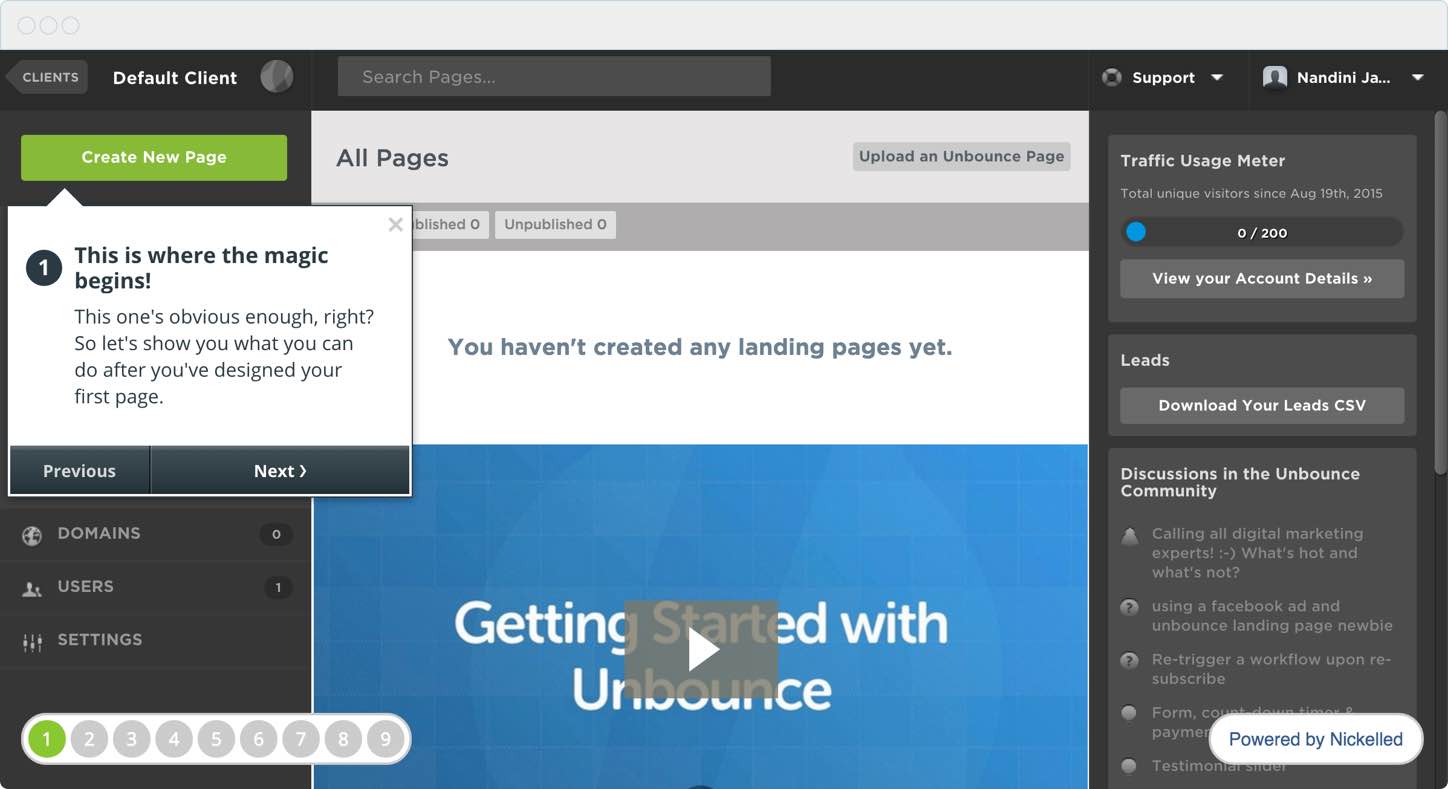Free Trials: Why Users Aren’t Converting to Customers

The free trial is a basic marketing tactic: Allow people to use the product freely for a while in their own context (their data, their business, etc.) and if they want to keep using it, they have to buy it. You’ve probably seen a “sign up for a free trial” button on countless SaaS websites.
Think of a free trial like an audition. It’s an opportunity to demonstrate the value of your product before users commit to a relationship with you. Free trial users are warm leads. They’ve expressed interest in your product and now need to be sold on it.
First, let’s keep one thing in mind: A free trial user who fails to buy the product is a non-conversion, not churn. Your churn rate is the percentage of customers who cancel their subscription in a certain period of time. If you are including non-conversions in your churn calculations, your churn rate will seem enormously high.
That said, many of the same strategies that you use to reduce churn also work to encourage conversions. Reducing churn is mostly about helping the customer receive value. Coincidentally, free trial users want to see value, too!
According to customer success thought leader Lincoln Murphy, a reasonable conversion rate for free trials to paid customers is 25-50%, depending on the maturity of your company.
Unfortunately, many companies aren’t working with a luxurious 50% conversion rate. 15-20% is the norm. If you’re in that boat it’s because you’re making one or several of these big mistakes.
1. You aren’t encouraging enough usage
The Journal of Marketing Research ran a study on free trial users. They found product usage tied closely to conversion rates. “When it comes to free trial customers [the usage intensity] effect appears to be particularly strong, suggesting it may be in a firm’s interest to encourage usage among these customers.”
Bluenose found that lack of usage with a SaaS product was the #1 driver of churn. Like I said, even though non-conversions shouldn’t be calculated as churn, we can fight both behaviors the same way.

Source: bluenose.com
The right usage is important, too. How your users interact with the product will affect their likeliness to buy it. You have to figure out what your users value and give it to them.
The blogging platform Ghost incorrectly assumed conversions would occur once customers published a blog post. When they investigated the actions taken by users who eventually converted, they learned that selecting a theme was the key step.
When they updated their onboarding process to include theme selection, conversions increased by more than 1,000%! For whatever reason, users found that one step especially valuable.
Use analytics and customer interviews to discover what your users find valuable. Determine the key value moments, then map your onboarding process to hit each moment.
2. You don’t demonstrate the product
Your product probably isn’t as intuitive as you think. You’ve spent hours working with it, so it makes sense to you. But you’re too close to the product to see it from the users’ perspective.
If a customer can’t figure out how to use your product, they will never buy it. Ever. The seeds of churn are planted the moment a user struggles to figure something out.
Add a demonstration during the onboarding process to walk the user through the use of your product. Demonstrations come in two varieties.
1. Video demonstrations – These are basic videos that explain the interface, features, and how to get the best use of the product. Make videos available on your home page, in your onboarding email sequence, and directly within the product. If you have the resources, a library of how-to videos added to your knowledge base can be powerful converters.
2. Live demonstration – Have someone at your company share their screen with potential customers and walk them through the product. These are extremely valuable because the user can get specific information, reducing the likelihood of confusion. This is a high-touch tactic, so it’s not suitable if your product has thousands (or millions) of users.
3. In-app walkthroughs – A walkthrough is an interface-led exploration of your tool. Users are prompted to click certain features or input certain information in a logical sequence. Walkthroughs are great ways to force interaction with the product and teach usage.
Here’s an example of a walkthrough that shows the user how to use Unbounce.

Source: nickelled.com
The depth of your demonstration can vary as well. If you sell a $30/month calendar tool, your users aren’t willing to spend three hours on the phone with you. But if you sell $100K/year enterprise software, your users will expect generous test time. You’ll have to balance your customer’s expectations with what you can afford to provide.
3. You aren’t providing the right content
Users expect boatloads of content to support their products. They want knowledge bases, blogs, whitepapers, tweets, and plenty of emails.
But you can’t just send them anything. Your content has to matter. It has to enhance the customer experience.
The first step is to send relevant content is to understand your customer’s goals. Their goals are usually broader than your tool addresses. For instance, a customer who purchases a CRM tool would also be interested in marketing topics, business growth topics, and productivity topics.
Make sure you provide robust documentation. Be efficient, but address every question and problem you can. If several customers have the same problem, you can guarantee others do as well. Edit or create an article to address it.
Most importantly, as you build content, serve it. Distribute new blog posts. Alert users to new knowledge base entries. Did you provide a specific solution for one customer? Let everyone else know; maybe they could use it as well. Your customers need to know that you’re a problem solver.
Don’t be afraid to reach their inboxes with automated emails. Send a welcome sequence that walks the customer through onboarding. Send them congratulatory emails when they achieve certain milestones. Send them reminders about features, information sources, and community centers. Most importantly, pitch them the paid version of your product when they near the end of the trial.
Guy Marion, CMO of Autopilot, recommends that you “micro-analyze the hurdles and buying decisions faced by a user, then deliver personalized in-product, email, and direct touch points to guide a user through their journey towards ‘aha’ or magic moments.”
Content won’t grow your business immediately. Be prepared to play the long game. No single blog post or email message will create explosive growth. Over time the cumulative effect of content will encourage more users to turn into customers.
4. Your free trial is too long
Many trials default to 30 days. Totango’s benchmark SaaS study found that 41% of SaaS companies offer a 30-day trial. A month is a comfortable number. It gives users plenty of time to experiment with the product, right?
According to Close.io, users don’t spend much time trialing your product. “If you look at the usage statistics of free trial users, you’ll find the vast majority don’t take full advantage of your trial. Only a tiny minority will use your product for more than three days in a row during a trial.” If you can’t turn a free user into a customer in a few days, you’ve probably lost the sale.
There’s a psychological effect to short trials as well. Users are motivated to learn your product because they know they only have a short window. Accounting and payroll software KashFlow created a 25% increase in conversions to paid customers by drastically shortening their free trial period.
Truthfully, there’s no cut-and-dry rule governing free trial length. You should choose a window that works for you by considering these factors.
- How long it takes the user to learn to use the features
- How long it takes the user to evaluate if the product is a good fit
- How the trial length will affect your sales cycle
- How long you can financially support a free use.
As always, check your analytics. If customers make their decision (either by converting or never logging in again) after a few days, shorten your trial to three or seven days to create more urgency and reduce your customer acquisition costs.
One last thought
There’s rarely a silver bullet that ramps up a company’s free-to-paid user conversion rate. Stories of explosive growth are rare and sensational. That’s why we hear about them.
In most cases, optimizing your conversions is a slow grind. This week you increase it by 5%. Next week by 7%. On and on. Keep optimizing engagement and you’ll get there.
If you want some advice about keeping your customers engaged, speak with us.
